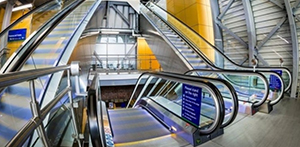
08 March 2023 | Stannah Lifts Limited
Escalator history and its inventors
From idea to patent to prototype to a full working system, escalators illustrate a common human quest: to make life easier. Read more about escalator history and when escalators were invented...
Escalators, as we know them, originated in 19th-century America, closely followed by France and Germany, taking just 40 years to become commercially viable. Now in use worldwide, escalators are essential people-movers in heavy footfall venues such as airports, shopping malls, hotels, rail stations, stadiums and arenas.
The first escalator patent
In 1859, patent solicitor and writer Nathan Ames of Massachusetts held the first escalator patent in the United States for his ‘Revolving Stairs’ − but the idea did not move beyond this stage.
“…The nature of my invention consists in arranging steps, or stairs, upon an inclined endless belt, chains, or ropes, or in attaching the stairs or steps together by links or joints so as to form an endless inclined flight of steps or stairs, which are placed on, over, or around, rollers so that the stairs or steps shall serve as elevators when motion is transmitted to the rollers…”
Around the same time, in 1867, Stannah was founded in London, making hoists and cranes for city dockyards.
Leamon Souder’s the Stairway was patented in 1889 in Philadelphia but remained unbuilt. It was the first of four escalator-style patents issued to him, including two for spiral designs.
Who invented the escalator, and when?
It wasn’t until 1892 that the first working escalator materialised, or ‘Endless Conveyor or Elevator’ as it was named by inventor Jesse Wilford Reno. With a 25o incline, this slow-moving, single-platform conveyor belt was showcased in 1896 at the Old Iron Pier, Coney Island in New York City.
The world’s first commercial escalator
In the same year, George A. Wheeler’s patent for a flat-step moving staircase was bought by inventor Charles Seeberger and transformed into a prototype built by Otis Elevator Company in 1899 − the world’s first commercial escalator. Comprising smooth treads from which the passenger had to dismount sideways, it won first prize at the 1900 Paris Exposition Universelle.
Charles Seeberger coined the term ‘escalator’ in 1900. A portmanteau of Latin ‘scala’ (stairway), e and tor = means of traversing from.
In the early 1900s, Stannah was busy expanding its product range into passenger lifts, goods lifts and car lifts, offering an innovative, complete range of lift products.
Also exhibiting at the Paris Exposition Universelle were two different contraptions by French manufacturers, Piat and Hallé. Hallé continued to sell its device in Europe but was swiftly overtaken by bigger manufacturers.
The UK’s first escalator
Piat installed England’s first escalator in Harrods, London, in 1898. 40’ high and powered by a continuous leather belt comprising 224 linked ‘steps’ caused quite a stir among its first users…
"Customers unnerved by the experience were revived by shopmen dispensing free smelling salts and cognac.” - The Department Store: A Social History, William Lancaster.
“There can be no doubt as to the invention's usefulness, and they should soon be in general use in railway stations, public buildings, hotels, warehouses, &c.” - Press Opinion: Warehouseman and Draper.
Escalators in the London Underground
In 1906, the world’s first spiral escalator (thanks to pioneering inventor Jesse Reno’s dogged perseverance) was installed in Holloway Road station, London. It ran at 30m a minute, rising just over 10m in height. Never used and abandoned as unsafe, this radical invention was lost to the world and did not resurface until inadvertently unearthed in 1988 at the bottom of an old lift shaft.
The first working escalator on the Underground was installed at Earl's Court in 1911; in fact, they installed two! They were an instant success; from 1912, all new deep-level stations were provided with escalators instead of lifts. According to Transport for London, there are 440 passenger escalators and 184 passenger lifts across the Tube network today. But they're not your typical escalator as they travel up to 0.75 metres per second, faster than the 0.5 metres per second escalators used in shops and department stores, also with a longer landing length.
Modern escalators becoming a common occurrence...
Escalators rapidly gained a firm grip throughout the world − not just in number but in type, from helical (spiral) and wheelchair access to the Levytator, an escalator capable of following free-form curves, and named after its inventor, Jack Levy, Emeritus Professor of Mechanical Engineering at City University London.
In 2010, Stannah welcomed escalators to its flourishing lift product portfolio.
Today
Today, escalators are used all over the world. Their advantages over passenger lifts are many, mainly in the ability to transfer far greater numbers of pedestrian traffic over the same time (although they can't accommodate wheelchair users).
They can be easily installed in places that are designed for ordinary staircases, and they can even be used outdoors (with adequate waterproofing protection). Escalators are often installed in department stores, supermarkets, airports and train stations.
Like their lift buddies, we here at Stannah love all the escalators we install and service, so we want to leave you with our top three fun facts:
A single 1m wide escalator can move up to 4500 passengers in an hour
Over its 40-year lifespan, an escalator will typically travel the equivalent distance of a trip to the moon and back
Waterloo has the most escalators out of all the Transport for London stations - 23, with Stannah installing the most recent escalators.